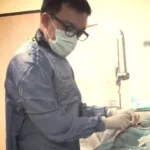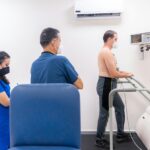Recovering from an angioplasty is a big step forward in your heart health journey, but it’s also the beginning of a new chapter. Once your doctor gives the go-ahead, staying active becomes one of the most important parts of your recovery. The right exercises can strengthen your heart, improve circulation, and boost your overall well-being.
This guide breaks down five low-impact, cardiologist-approved exercises you can safely include in your post-angioplasty fitness plan, designed to help you get stronger, one day at a time.
Key Pointers to Keep in Mind
- Start only after your cardiologist confirms you’re ready.
- Focus on low-impact movements that build endurance gradually.
- Avoid heavy lifting or high-intensity workouts in the first few weeks.
- Listen to your body. If you feel dizzy, short of breath, or fatigued, stop and rest.
- Join a cardiac rehabilitation programme if recommended; it’s one of the safest ways to recover.
1. Walking: Your Foundation for Recovery
Walking is one of the safest and most effective exercises after angioplasty. It strengthens your heart and lungs without putting too much strain on your body.
How to start:
- Begin with 5–10 minutes of slow walking, two or three times a day.
- Gradually increase the duration by a few minutes each week.
- Walk at a pace where you can still hold a conversation comfortably.
Why it helps:
Walking improves blood circulation, lowers blood pressure, and boosts energy levels, ideal for those easing back into activity after heart procedures.
2. Stationary Cycling: Gentle Cardio Indoors
If your recovery is going well, stationary cycling is a great next step. It’s low-impact and easy to control, allowing you to manage speed and resistance safely.
How to start:
- Use a stationary bike at low resistance for 10–15 minutes.
- Keep your posture upright and maintain steady breathing.
- Avoid pushing hard or standing up while cycling in the early stages.
Why it helps:
Cycling strengthens leg muscles and supports heart function without the joint stress that comes from running or high-impact exercises.
3. Light Stretching: Keep Your Body Flexible
After a hospital stay or period of rest, your muscles can feel stiff. Gentle stretching keeps your body flexible and reduces muscle tightness.
How to start:
- Do 5–10 minutes of light stretching before and after your walk.
- Focus on the shoulders, neck, calves, and back.
- Move slowly, never bounce or push too hard.
Why it helps:
Stretching improves range of motion, supports good posture, and helps prevent injuries during your recovery workouts.
4. Breathing Exercises: Calm the Mind and Strengthen the Heart
Heart recovery isn’t just physical, it’s also about managing stress and anxiety. Deep breathing can lower blood pressure and improve oxygen delivery to the heart.
How to start:
- Sit comfortably, inhale deeply through your nose for four counts, hold for two, then exhale through your mouth for six.
- Repeat for 5–10 minutes daily, especially before sleep or when feeling tense.
Why it helps:
Controlled breathing promotes relaxation, reduces stress hormones, and can help stabilise heart rhythm.
5. Cardiac Rehab Exercises: Guided Recovery
If your cardiologist recommends it, joining a cardiac rehabilitation programme is one of the safest and most effective ways to return to fitness.
What to expect:
- Supervised exercise sessions tailored to your condition.
- Education on heart-healthy habits, nutrition, and medication management.
- A gradual increase in activity levels based on your progress.
Why it helps:
Rehab programmes offer medical monitoring and emotional support, helping you rebuild confidence in your physical abilities while reducing the risk of future heart issues.
Rebuilding Strength Takes Time, and Patience
After angioplasty, your heart is healing and adapting to improved blood flow. Don’t rush the process. Gradually increasing your activity, eating well, and getting enough rest will support your recovery more than any intense workout ever could.
FAQs About Exercise After Angioplasty
1. When can I start exercising after angioplasty?
Usually, light activity such as short walks can begin a few days to a week after the procedure, once your doctor clears you. Avoid strenuous activity until you’ve had your follow-up appointment.
2. Can I go back to the gym?
You can, but gradually. Start with light cardio and avoid lifting heavy weights for at least four to six weeks, or until your cardiologist says it’s safe.
3. Is chest discomfort normal during exercise?
Mild tightness or fatigue may occur early on, but sharp or persistent chest pain is not normal. Stop exercising and seek medical advice immediately.
4. What if I feel anxious about exercising again?
It’s common to feel nervous after a heart procedure. Joining a cardiac rehab programme can help you regain confidence while exercising under supervision.
5. How can I tell if I’m doing too much?
If you feel dizzy, breathless, or overly tired, or if your heart rate rises too quickly, slow down. Recovery is about consistency, not speed.
Take the Next Step with The Heart Doctors Clinic
At The Heart Doctors Clinic, we help patients safely return to active, fulfilling lives after angioplasty. Whether you’re starting gentle walks, enrolling in a cardiac rehab programme, or planning a gradual exercise routine, we’re here to guide you.
Your next steps:
- Book a post-procedure review to discuss your fitness goals and safe activity level.
- Get personalised guidance on exercise progression and heart-friendly habits.
- Stay consistent and informed, because every small step strengthens your heart.
Your recovery doesn’t end with the procedure; it begins with it. With the right plan, patience, and professional support, you can look and move forward with confidence and a stronger heart.








